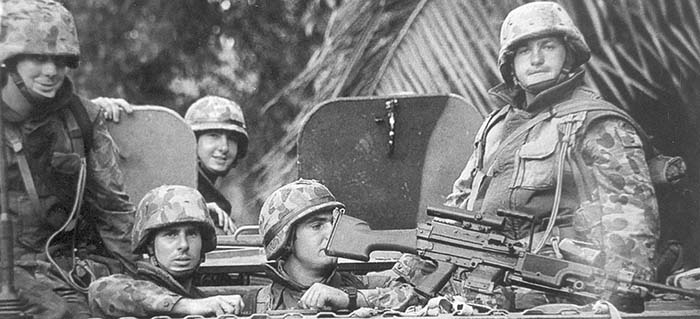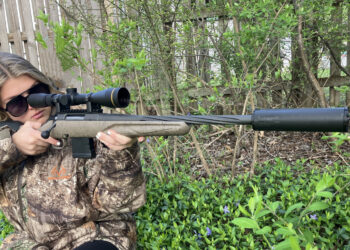Section from the 3 RAR on a 2 Cavalry Regiment ASLAV personnel carrier in East Timor. Weapon is a F89A1-LSW.
by J.c. Henly & Rob Krott
With the involvement of Australian forces in World War II (both in the North African Desert campaign against the Germans and Italians and in the Pacific against the Japanese) the Australian military found itself using nearly obsolete British weaponry and in need of additional, and more modern, armaments to equip its combat forces. Prior to World War II the Australian Military Forces (AMF) didn’t envision a role for Airborne (paratroop) or Commando units. This soon changed dramatically and by 1944 the Australians had formed a Parachute Battalion, a number of Independent Commando Companies, and the Clandestine Service Reconnaissance Department (SRD). As the war progressed the AMF realized its issue weapons were largely unsuitable for special operations and jungle warfare. The Short Magazine Lee Enfield (SMLE) No. 1 Mark III .303 rifle and No. 4 Enfield .303 rifle, while perhaps suitable for firing from the trenches in Europe in the previous war were definitely too heavy and ungainly for parachute troops and small, quick moving jungle recon teams. Lighter weapons, preferably full automatic for greater firepower, were needed. The Australian government quickly rushed two new weapons into production: the Mark 1 Austen Submachine Gun and the Mark 1 Owen Submachine Gun, both chambered for the 9x19mm pistol cartridge then in use.
Australian Submachine Guns
The Austen (a contraction of “Australian Sten’) was externally similar to the British 9x19mm Sten submachine gun. This was because the British had furnished the Australians with working models and blueprints along with manufacturing information for the Sten in late 1941. The British Sten gun, however, proved unsuitable for the Australians, who modified the basic design by using the internal mechanism, changed some external designs, and incorporated the folding stock of the German MP40. This resulted in the Austen, which also incorporated the MP40’s telescoping recoil spring cover and firing pin assembly. Later, the Mark II Austen utilizing a two-piece receiver cast from aluminum to speed production was introduced. By the end of the war Diecasters Ltd. and W.T. Carmichael of Melbourne had produced some 20,000 Austens and a small number of a silenced version, the Austen Mark 1 (S), for use by the SRD.
More popular and more widely recognized as a uniquely Australian weapon with its top-mounted 30-round box magazine and rough appearance was the Owen Submachine Gun. Named for its inventor, Evelyn Owen, it was to undergo a number of improvements and variations during its service life, remaining in service with the AMF until the 1960s. British forces also used a significant number of Owen submachine guns in the post-war Malaysian counter-insurgency. Some 45,000 Owens had been produced by the Lysaghts Newcastle Works, New Castle, South Wales by the end of World War II and its ruggedness and dependability made it the weapon of choice by the Australian Commandos.
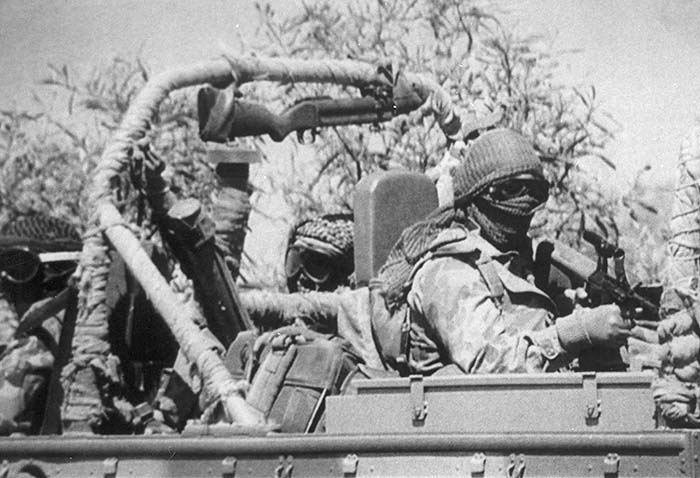
Commandos and SAS
With the end of the war in 1945 the Airborne and Commando units were disbanded and their men re-assigned to conventional army units. Airborne training was not re-introduced for Army personnel until 1951 and in 1955 it was decided to re-raise two Commando Companies as part of the Citizens Military Forces (CMF/Reserve). These were to be (and still remain) No. 1 Commando Company in Sydney, New South Wales, and No. 2 Commando Company in Melbourne, Victoria. In 1957 it was decided to also raise an Australian Special Air Service (SAS) unit, nearly identical in make-up, training, and mission as the British special operations unit of the same name, as part of the AMF, to be based in Perth, Western Australia, where they still remain.
Equipped with Foreign Weapons
Australian troops soon saw further action in Korea, Malaya, and Borneo. The Australians equipped their troops with the .303 Enfield rifles left over from World War II, being one of the few allied forces in the Korean War wholly equipped with bolt-action rifles. After their Korean War experience with the cumbersome bolt-action rifles, the Australian soldiers deployed to Malaya in 1955 were only too happy to receive a supply of modern FN FAL 7.62x51mm rifles from the British Army. They were also issued US Army surplus .30 M1 Carbines, and 12 gauge Model 870 Remington shotguns as well as the .303 No.5 Enfield “Jungle Carbine.” The only Australian-made weapon carried by AMF in Malaya was the venerable Owen.
Regarding the Jungle Carbines issued to the Australians, World War II operations in the Far East had prompted the British Army to lighten the soldier’s load and provide a weapon more suitable to jungle fighting. Feedback from the field favored something like the US .30 M1 Carbine. In 1943 the No. 5 Jungle Carbine was developed to meet the need for a light, short barrel carbine.
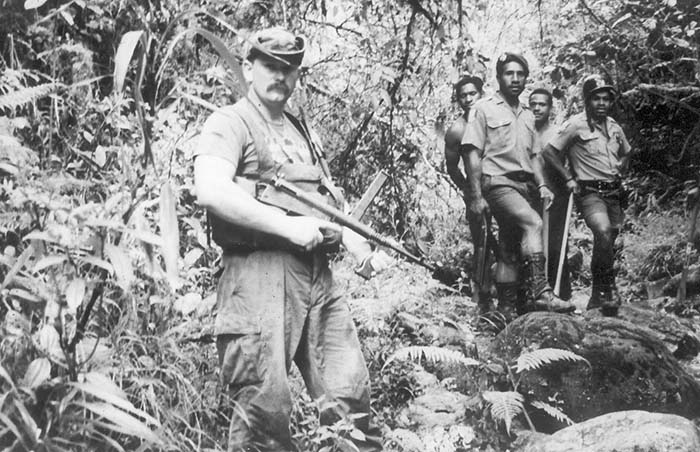
Approved for issue in September 1944 it was basically a shortened No. 4 Mark 1 Enfield rifle fitted with a bell-mouth flash hider, a short handguard, and a rubber recoil pad. Though it was considered for issue as a standard rifle after the war it was deemed obsolete in 1947. The No.5 Jungle Carbine was withdrawn from service because of design defects: 1) excessive recoil, and 2) failure to hold its zero. Yet this didn’t prevent it from being issued to the Australians deployed to Malaya in 1955. With its hodgepodge of foreign weaponry it was obvious to the Australian Army that they needed their own standard issue weapons. It would be a few more years but eventually the diggers would get a modern military weapon to call their own.
z Arms 60’s Style
In 1962 the Australian Army formally adopted the 7.62x51mm L1A1 semiautomatic SLR (Self Loading Rifle) to replace the British FN FAL rifles in service since the Malaysian Insurgency and any .303 No. 1 Mark III SMLE rifles still in service with the Citizens Military Forces. The L1A1, based on the FN FAL but modified (to the standardized inch-dimension version as used by the British and Canadians) and manufactured under license in Australia at Lithgow, became the standard issue rifle of the Australian Army.
Weighing 12 pounds with an overall length of 44.8 inches it occasionally proved to be “too much gun” for some soldiers. A lighter, short-barrel version, the L1A1 F1, was introduced (it was supposedly designed as an export model intended for the Papua New Guinea Defence Force) for use by shorter stature soldiers. By using the flash eliminator as a barrel sleeve incorporated as a combined muzzle brake-flash suppressor nearly 3 inches were trimmed from the barrel length. Reducing the length of the buttstock further shortened the weapon. Some L1A1 F1 rifles were issued for use by Australian SAS troops, as the short barrel versions of the weapon were better suited to jungle warfare.
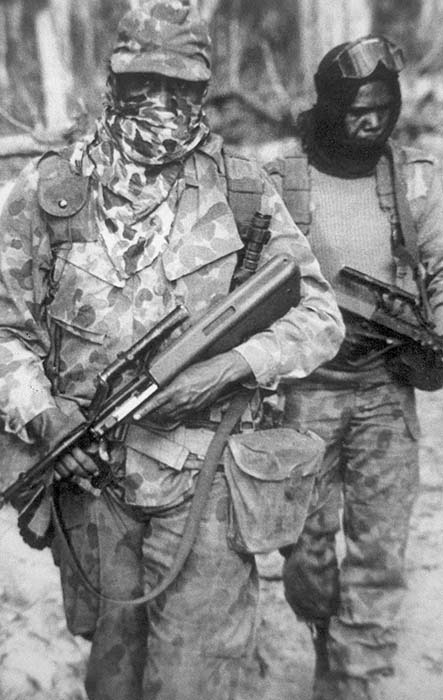
For increased firepower at the section (squad) level an automatic rifle version of the L1A1 was developed. The L2A1 Automatic Rifle incorporated a larger 30-round magazine, a heavy barrel, and a bipod, and weighed a little over 15 pounds. In service it was considered by many to be the equivalent to the by then obsolete Browning Automatic Rifle (BAR). To meet the requirement for a squad automatic weapon some World War II service Bren Light Machine Guns were modified, re-chambered to 7.62x51mm and re-issued as the L4A4. But like the BAR, the L4A4’s were still obsolete simply by virtue of their size, weight, and limited firepower (due to the need to frequently change its 30-round detachable box magazines). A number of 7.62x51mm FN MAG 58 GPMGs (known in the Australian supply system as the L7A1) were obtained later by the Australian Army. And although the L7A1 was a belt-fed machine gun, they were still not regarded as suitable. In the late 1950s the Australian Army adopted the U.S. M60 GPMG.
The same year the Australian Army adopted the L1A1 SLR (1962) also saw the demise of the Owen gun purportedly in favor of a lighter, more easily produced weapon with a lower rate of fire. The battle proven Owen was deemed obsolete and a new weapon was manufactured by the Australian Government Small Arms Factory at Lithgow, New South Wales, to replace it. Known as the X3 while in development the 9x19mm F1 submachine gun was, like the Owen, fed by a top-mounted magazine, although the F1 utilizes a British L2A3 (Sterling) 34-round staggered-column, detachable box magazine. The F1 was a fully automatic, blowback submachine gun with a cyclic rate of 600 rpm. Fully loaded it weighed the same (over 9 pounds) and despite a more “modern look” with its better finish and its ventilated cooling jacket it was never as popular with the troops as the Owen. With the acquisition of some Colt M16A1 rifles the F1 was quickly relegated to use by armored crewmen, drivers, and military police. The only other 9x19mm weapon then in service was the FN Browning High Power designated by the Australian Army as Pistol, 9mm L9A1.
The reliable High Power is being supplanted, however. The recent deployment of the ADF to East Timor has seen the issue of 9x19mm Glock 17 semiautomatic pistols to those ADF personnel unable to carry the F88 rifle due to their duties. The Glock 19, aka “Model G19” is currently issued to RAAF flight personnel who call it the JAP – “Jet Aircrew Pistol.”
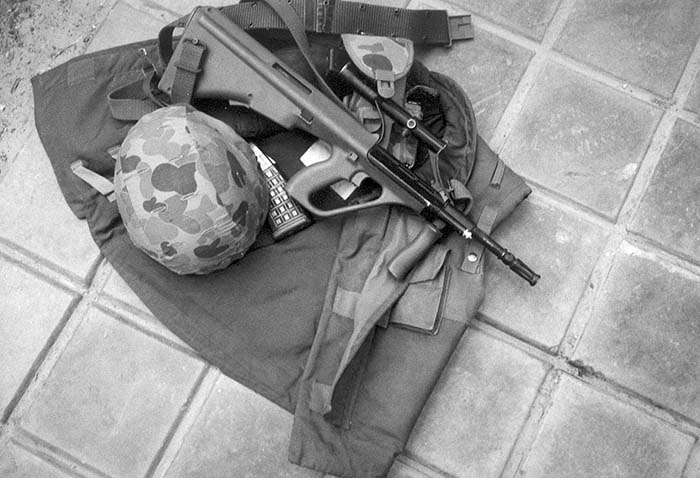
Indonesia 1960s
Much of the early 1960s re-equipment of the Army was to prove provident as in December 1962 President Sukarno of Indonesia declared Konfrontasi (Confrontation) against the British in Borneo. Lasting until 1966, this insurgency was to become an unknown and unreported war. In 1965 British and Australian SAS units began their first joint operations against the Indonesian Forces. The Australian SAS flew to Singapore where they were hastily issued US M18A1 Claymore mines, M26 hand grenades, and the new AR-15/XM-15 rifle (supplied to the British by the US) Also issued were Sabre Beacons, C-128 Radio Sets, British 58 pattern webbing and British jungle green uniforms. Dressed in British uniforms and carrying US weaponry, it was doubtful if killed in action whether the Indonesians could have accurately identified the body as being a dead Australian SAS trooper. In March 1966 President Sukarno was deposed in a coup led by General Suharto and in August of that year a peace agreement was signed.
Vietnam
After the Borneo imbroglio the SAS along with other units of the Australian Army were soon bound for Vietnam. Australian advisors to the Army of the Republic of Viet Nam (ARVN) were assigned to the Australian Army Training Team Vietnam (AATTV) as early as 1964. During these deployments the AATTV and SAS troops usually carried US weapons. While the 7.62x51mm M60 GPMG, the 40mm M79 and M203 grenade launchers, and 5.56x45mm M16 and M16A1 rifles were quickly adopted by Australian forces, the Australians continued to carry the L1A1 SLR as their main battle rifle. Even though the M16 was a lighter weapon capable of full automatic fire and a basic load of ammunition was lighter to carry, many of the Australian “advisors” preferred the heavier caliber L1A1 SLR for jungle fighting. By 1973 (the end of the Australian deployment in Vietnam) they were armed with a mix of SLRs and M16s.
Sniping Rifles
The AMF first fielded the .303 SMLE No. 1 Mk III* (HT) fitted with a heavy barrel and Pattern 1918 Australian telescopic sight as their sniper rifle. Approximately 1,600 of these weapons were manufactured during World War II and saw extensive service in both European and Pacific theaters. These rifles were largely replaced by the .303 No.4 Mk 1(T) Sniper Rifle with a Mk. 1 wooden cheek rest and No.32 Mk 3 Telescopic sight, considered the best sniping rifle of its time. Some were tuned up by the expert gunsmiths of Holland and Holland. These weapons were put together under wartime production stress. The No.32 telescopic sight was originally developed for use on Bren guns.
The No. 4T sniper rifles were later re-chambered for 7.62x51mm NATO, re-fitted with the L1A1 Telescopic sight, and designated the L42A1. The L42A1 is readily identified by a shortened fore-end cut in a sporter style. At best the L42A1 was a quick fix done to save on the development of a new rifle. Unfortunately the optics weren’t updated and the weapon continued to mount the World-War-II-era No. 32 telescopic sight. Even when first issued the L42A1 was a lack-luster sniping rifle. Many sporting rifles of the day were better. The British replaced the L42A1, the last Enfield rifle in service with its Army, with the Parker-Hale sniping rifles. The Australians followed suit, replacing the L42A1 rifles in their inventory with the 7.62x51mm NATO Model 82 Parker Hale Rifle mounting a Kahles Helia Model ZF69 Telescopic Sight. In addition to the Parker Hale, the SAS also use the PSG1 Heckler and Koch Sniper Rifle and a small quantity of .22-250 Tikka Model 55 (HB) Rifles.
In 1998 it was announced by the ADF that the Model 82 Parker Hale rifle in use by Australian snipers was to be replaced by a new weapon – the Accuracy International (UK) AW-F. Like the Parker Hale this is a 7.62x51mm bolt-action rifle but that is where any similarity ends. The AW-F, or SR98 as named by the ADF, has a reinforced nylon buttstock with thumb-hole grip, folding stock, butt spike, cheekpiece, and multi-adjustable butt plate. Other features are a quick release sight mount and a MIL-STD-1913 rail interface to allow for the use of other sights. The standard sight for use with the SR98 is the Schmidt and Bender 3-12x50mm variable power telescopic sight.
The ADF also has a requirement for a .50 caliber sniping rifle for use down to the battalion level. However, a determination is still forthcoming. Field trials with the Barrett M82A1 were recently conducted and reports were favorable.
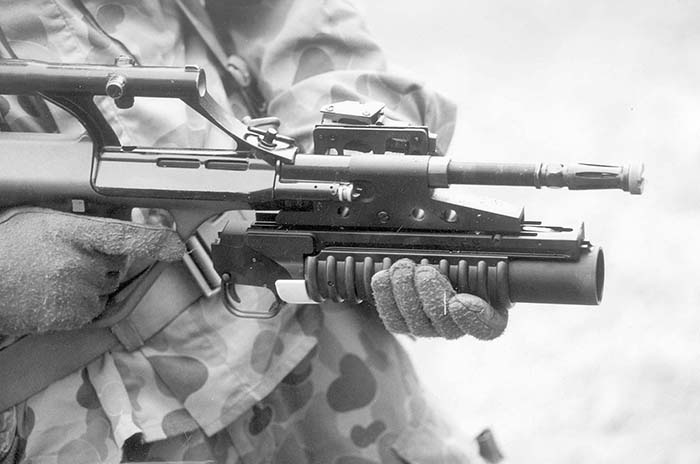
1970s to the 1990s
In the late 1970s and early 1980s the role of the Australian Special Action Forces changed focus from jungle and insurgency warfare to urban warfare and counter-terrorism. The Commando Companies of the Army Reserve (ARes) make extensive use of the M16A1, considered to be an excellent battle rifle. They also use the 9x19mm L34A1 Silenced Submachine Gun (British L2A3 Sterling), essentially a Sterling whose barrel jacket incorporates a suppressor.
The SAS squadrons of the Australian Regular Army (ARA) serve on a three-year training rotation. In their first year they attend specialist training courses; the second year is devoted to training in the SAS war role (sniping, reconnaissance, combat patrolling); in their third year they concentrate on counter terrorist training. In the late 1980s a Regional Force Surveillance Unit (RFSU) was established. Like the Commando Companies it is part of the ARes and its members (many of whom are Aborigines) live and train in Northern Australia.
Oz Arms 2002
The most significant changes in Australian Defence Force (ADF) armories have come about in the past decade. A period of reorganization, like that of the 1960s, has included a new small arms weapons system designed to serve the ADF into the 21st century. The Austrian Steyr AUG (Armee Universal Gewehr – universal army rifle) bullpup rifle was introduced in 1977 and was soon adopted by Saudi Arabia, Oman, and New Zealand. After test trials the Australian Government decided to arm its troops with the Austrian 5.56x45mm Steyr AUG. Like the L1A1, the Austeyr (Australian Steyr) is manufactured under license in Australia. The initial contract provided for the Australian manufacture of 85,000 Austeyr rifles. One difference between the Austrian and Australian models is that the “vine-catcher” type flash hider was replaced with a unit more conducive to jungle operations. There are three models in production: the Austeyr F88, the Austeyr F88-C (Carbine) with a barrel 4 inches shorter than the standard F88 rifle, and the Austeyr F88-S which lacks the integral 1.5 power sight, allowing the mounting of the AN/PVS-4 Night Vision Sight or other optics. The Steyr saw action in Somalia with the Australian contingent. A design problem, which could lead to accidental discharges, resulted in the wounding of one Australian trooper while on patrol near Baidoa. Reviews from the field concerning the Steyr’s suitability were mixed.
Steyr also manufactures and markets a suppressed 9x19mm AUG Carbine and a 9x19mm Tactical Machine Pistol (TMP) based on the 9mm Steyr MPi69 Submachine Gun. Whether the suppressed carbine or the TMP will be obtained by the Commandos to replace their L34A1 (suppressed Sterlings) is not definite. The SAS have already adopted the 9x19mm H&K MP5-SD3 (Suppressed) Submachine Gun as well as the MP5-A3 and the MP5-K for counter-terrorist work. They supposedly also have a few Beretta Model 92 pistols fitted with Knights suppressors.
The 5.56x45mm Minimi (M249 SAW) manufactured by FN Herstal is fielded in Australia as the F89 GPMG and is a product-improved version of the US M249. This includes a heavier profile barrel, closed prong flash suppressor, black marnyl butt and removal of the load indicator on the feed cover. The FN Minimi is a reliable light machine gun that rarely incurs stoppages. It incorporates a variable gas supply and a rotating bolt breech system. Its unique feed system allows it to load either belted ammunition or box magazines (M16-type) without any adjustment. The belts load in the belt feed on the left side whereas the box magazines load into a lower magazine housing. The rate of fire is slightly higher for magazine fed operation, as the cyclic rate is not slowed by the feed mechanism pulling the weight of the belt. The F89 replaces the L1A2, L4A4, M60, and MAG-58 machine guns (all of which are still in use). The latest model of the F89 (M249 SAW) GPMG now in service is known as the F89A1-LSW. In the infantry battalions the front sight has been removed and the weapon equipped with an optical sight. The F89A1 has an improved extractor, improved feed tray cover hold open springs, and a hydraulic buffer assembly. The current optical sight is the same as that used on the F88 rifle, but the 1.5X sight is only adequate for short ranges. With the F89 intended to engage targets beyond 400 meters a new 4X optical sight mounted on a MIL-STD-1913 rail assembly is planned. AN/PVS-4s have also been mounted on the F89. The Australian SAS which also continues to use the L1A1 (SLR) and M16 rifles (the F88 Austeyr is not highly favored), will retain the MAG-58. The SAS, because of its elite role and unique needs, will continue to equip itself with whatever weapons it desires. The remainder of the Australian Military Forces must, as they always have, work with what they are issued.
J.C. Henley is a former Australian Army infantry corporal and paratrooper. The author of Australian Parachute Insignia, he frequently writes on military weapons, history, and insignia. Rob Krott is SAR’s military affairs correspondent.
| This article first appeared in Small Arms Review V7N7 (April 2004) |



